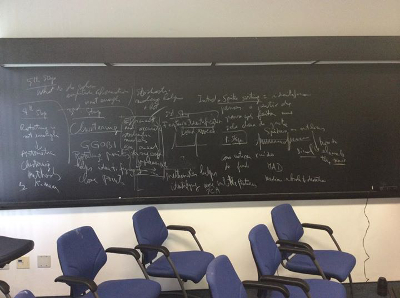
"Spike Sorting," a NeuroMat movie
Jun 30, 2015
The Research, Innovation and Dissemination Center for Neuromathematics (FAPESP’s CEPID NeuroMat) released in June the movie “Spike Sorting: Ontology Droplet,” a nine-minute-long introduction and step-by-step presentation of a technique to classify neuronal spikes featuring Prof. Christophe Pouzat, a researcher of the Applied Maths Laboratory of the Paris-Descartes University and a specialist in spike sorting. The movie is available with subtitles in English (original language) and in Portuguese on Youtube and Wikimedia Commons. Released under a Creative Commons license (CC BY-SA 3.0), the movie may be freely shared, as long as original attribution is properly specified.
“Spike Sorting: Ontology Droplet” was acknowledged as “Media of the Day” (June 10) on Wikimedia Commons and displayed on the front page of over 200 related websites. Wikimedia Commons is an online repository of images and media files that are used on Wikipedia and across Wikimedia projects in all languages. A list of websites that have published the NeuroMat movie is available on the aforementioned link to Wikimedia Commons. Produced and edited as relatively easy-to-grasp content, the movie was made available on Wikipedia entries on spike sorting in English and Portuguese. In June, these Wikipedia entries and the Wikimedia Commons file had together 795 views. On Youtube, the movie was viewed 153 times in June. The movie was acclaimed by several researchers, including mathematician Eva Löcherbach, physicist Daniel Fraiman and neuroscientist Sergio Neuenschwander. “Congratulations on this wonderful work,” commented Prof. Patricia Reynaud-Bouret, a CNRS Researcher at Nice Sophia-Antipolis University.
Film Design
“Spike Sorting: Ontology Droplet” was envisioned and shot in the context of the NeuroMat workshop "Spike sorting: What is it? Why do we need it? Where does it come from? How is it done? How to interpret it?,” at the end of November, 2014. A full description of the workshop, including access to videos, presentation slides, media coverage and pictures, is available at NeuroMat’s Newsletter #10. The event drew wide interest at the time, including over 500 people that watched the workshop on live streaming, thus justifying the investment. The intent of the movie was to present a shortened version of part of the content that was discussed during the November workshop. From this perspective, the movie script expected to bring up most important points and tasks pertaining to spike sorting.
 |
Parts of the movie are fivefold. In the first part, Prof. Pouzat introduces the concept of spike sorting and relates it to the advancement of neurophysiology. In the following part (starting at 1:28), he discusses how to isolate spikes from background noise, what he calls the first task of spike sorting. The third part of the movie (starting at 2:32) brings up the technique to group spikes based on similarity of amplitude. Then (starting at 3:55), Prof. Pouzat talks on clustering strategies, referring specifically to an automatic method called Principal Component Analysis. The final part of the movie (starting at 7:15) emphasizes the need of developing stochastic models to make sense of neuronal datasets, hence avoiding potential misinterpretations.
The movie was an original idea from Prof. Pouzat and Prof. Antonio Galves, NeuroMat’s coordinator, and was made possible by the collective effort of Simone Bega Harnik, André Frazão Helene, Dário Augusto Oliveira, João Alexandre Peschanski, Carlos Ribas, Antonio Carlos Roque and Evandro Santos Rocha. Parece Cinema, a filmmaking team, was responsible for the production, filming, art and final edition.
Neuronal Soundtrack
“Spike Sorting: Ontology Droplet” features an original soundtrack, called “Spikes,” that remains analogous to how spikes occur in the brain. The soundtrack combines background noise, a continuous background, and distinguishable, nonperiodic sharp notes. Artists Alexandre Peixoto and Bruno Harnik produced this soundtrack, with statistical support from Simone Bega Harnik. An important feature of the soundtrack is that notes as spikes occur aleatorily. Spikes are thus represented by four different sounds with specific statistical distribution.
Continuing activities
NeuroMat’s movie is part of continuing activities to enhance the understanding of spike sorting, an area of research that naturally brings together scientists from several backgrounds. Spike sorting was a topic of presentation and active work in two scientific conferences NeuroMat organized in 2015. During the First NeuroMat Young Researchers Workshop in São Paulo, from May 5 to May 7, Bruno Monte de Castro, a NeuroMat researcher, presented on "Spike sorting for interacting neurons”. Spike sorting also featured in the Workshop on Stochastic Modelling of Neural Nets and Spike Sorting, from May 26 to 28. Prof. Pouzat was a participant in the latter, when “Spike Sorting: Ontology Droplet” had its avant-première.
NeuroMat’s scientific dissemination team is currently working on two new videos. A short manifesto-movie on Open Science and a filmed document of an experiment on brain and rhythms should be released this term.“Spike Sorting: Ontology Droplet” has been seen as the first of a series of what has been called a NeuroCineMat initiative.
This piece is part of NeuroMat's Newsletter #17. Read more here
Share on Twitter Share on Facebook| NeuroCineMat |
|---|
|
Featuring this week: |
| Newsletter |
|---|
|
Stay informed on our latest news! |
| Follow Us on Facebook |
|---|




